
Brief History
According to the CIA:
The Sultanate of Brunei's influence peaked between the 15th and 17th centuries when its control extended over coastal areas of northwest Borneo and the southern Philippines. Brunei subsequently entered a period of decline brought on by internal strife over royal succession, colonial expansion of European powers, and piracy. In 1888, Brunei became a British protectorate; independence was achieved in 1984. The same family has ruled Brunei for over six centuries. Brunei benefits from extensive petroleum and natural gas fields, the source of one of the highest per capita GDPs in Asia.According to the Brunei Government:
From the 14th to the 16th centuries Brunei Darussalam was the seat of a powerful sultanate extending over Sabah, Sarawak and the lower Philippines. Thus, the current Sultan represents one of the oldest continuously ruling dynasties in the world. By the 19th century, the Brunei Darussalam Empire had been whittled away by wars, piracy and the colonial expansion of European powers.
In 1847, the sultan concluded a treaty with Great Britain and in 1888 Brunei Darussalam officially became a British protectorate. In 1906, the Residential System was established in Brunei Darussalam. A British Resident was nominated as a representative of the British government to advise the sultan in all matters except Malay customs, traditions and Islamic religion.
The 1959 Agreement established a written constitution which gave Brunei Darussalam internal self-government. In 1971, the agreement was amended and revised to assert full internal independence except defence and external affairs.
In 1967 His Highness Sultan Haji Sir Muda Omar Ali Saifuddien abdicated in favour of his son Pengiran Muda Mahkota Hassanal Bolkiah. On January 1, 1984 Brunei Darussalam resumed full independence and the Sultan took office as Prime Minister, Finance Minister and Home Affairs Minister, presiding over a cabinet of six. In October 1986, the cabinet was expanded to 11 members, with His Majesty relinquishing the portfolios of Finance and Home Affairs and taking over the Defence portfolio which his late father had held since 1984. In 1988 another reshuffle brought about the elevation of the deputy minister to a full minister and the creation of the Ministry of Industry and Primary Resources designed to boost the country's development.
Brunei Gold Coins Although Brunei issued its own coins as early as 1285 AH (1863 AD), there was then a gap until 1967, and it issued no gold coins until as recently as 1978.
Description
The obverse has a coloured portrait of the Sultan of Brunei, Haji Hassanal Bolkiah.
Minted by Huguenin Freres of Le Locle Switzerland.
Technical Specifications
| Denomination | Diameter | Weight | Fineness | Gold Content |
|---|---|---|---|---|
|
50 Dollars
|
33.0 | 31.14 | .9166* | 0.917* |
|
50 Dollars
|
33.0 | 31.14 | .9999* | 1.0000* |
|
100 Dollars
|
27 | 13.50 | .9170 | 0.3976 |
|
1,000 Dollars (1988)
|
37 | 50.00 | .9170 | 1.4742 |
Notes
* The certificate which accompanies the coin states the gross weight to be 31.1 grams, Krause gives it as 31.1035 grams, and we weighed our coin at 31.1446 grams; so far, so good, as this is within reasonable tolerance limits, but...
The certificate states the alloy to be 22 carat gold, and Krause states .9170 fine, which once again mean the same, within reasonable tolerance. Krause then states the "AGW" (Actual Fine Gold content) to be 1.0000 troy ounces.
If the certificate and Krause are correct about the gross weight and alloy, then the actual gold content would be 0.9167 troy ounces, and this is a reasonable assumption, however it's our guess that Krause may be correct about the AGW, and that the certificate (and Krause) have stated the alloy incorrectly as 22 carat (.917), and that the actual alloy is .9999 or possibly .9990 fine.
The coin is a very pale yellow colour, very similar to fine gold, so this latter assumption may be the correct one, however, if an alloy of 22 parts gold, and 2 parts silver was used, this would also produce a similar pale yellow colour.
Most other Brunei gold coin issues have been 22 carat gold, but a $1,000 issued in 1994 was produced in .9999 fine gold, so this gives no clear indication of which alloy was used for the 1996 issue under discussion.
We will attempt to discover which version is correct, but this may take some time.
1996 Gold $50 - 50th Anniversary of Sultan Haji Hassanal Bolkiah
Postage & Packing
UK Registered Post (Special Delivery) £9 per order
EU Insured Post £10 per order
USA Airmail $10 per order
USA Insured Shipping $20 per order
Brunei Silver and Base Metal Coins
For silver and base metal coins of Brunei, please look at our original Chard Coins
website.
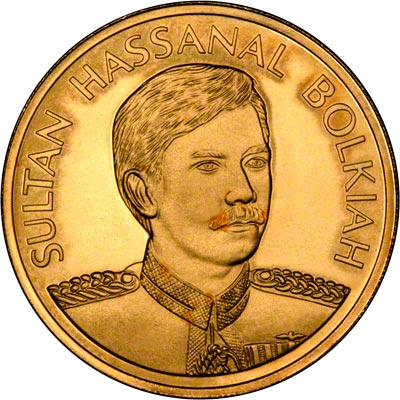
Obverse of 1987 Brunei 100 Dollars Coin
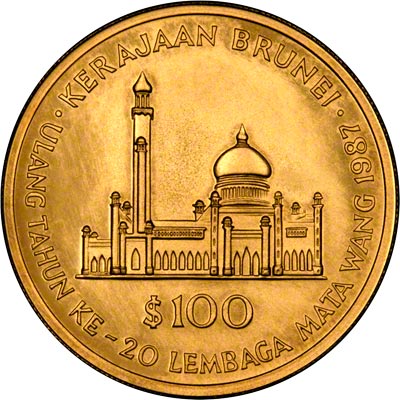 Reverse of 1987 Brunei 100 Dollars Coin
Reverse of 1987 Brunei 100 Dollars Coin
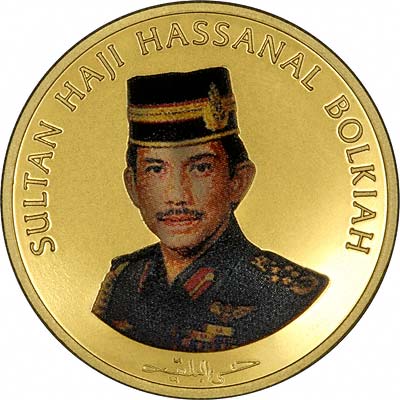 Obverse of 1996 Brunei Gold 50 Dollars
Obverse of 1996 Brunei Gold 50 Dollars
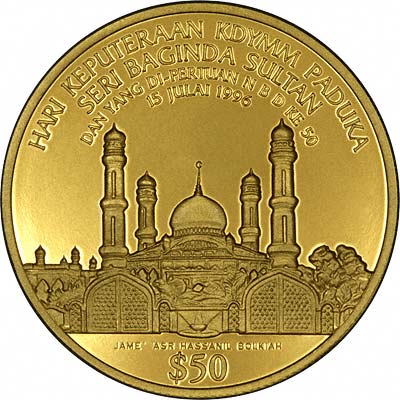 Reverse of 1996 Brunei Gold 50 Dollars
Reverse of 1996 Brunei Gold 50 Dollars
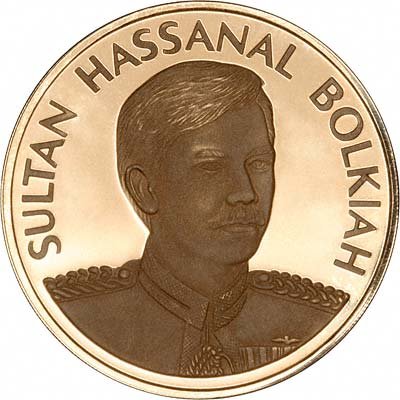 Obverse of 1998 Brunei Gold 1,000 Dollars
Obverse of 1998 Brunei Gold 1,000 Dollars
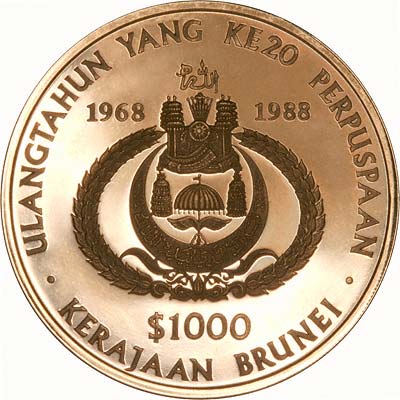 Reverse of 1998 Brunei Gold 1,000 Dollars
Reverse of 1998 Brunei Gold 1,000 Dollars
32 - 36 Harrowside, Blackpool, Lancashire, FY4 1RJ, England. Telephone (44) - (0) 1253 - 343081; Fax 408058;
E-mail: Contact Us The URL for our main page is: taxfreegold.co.uk
